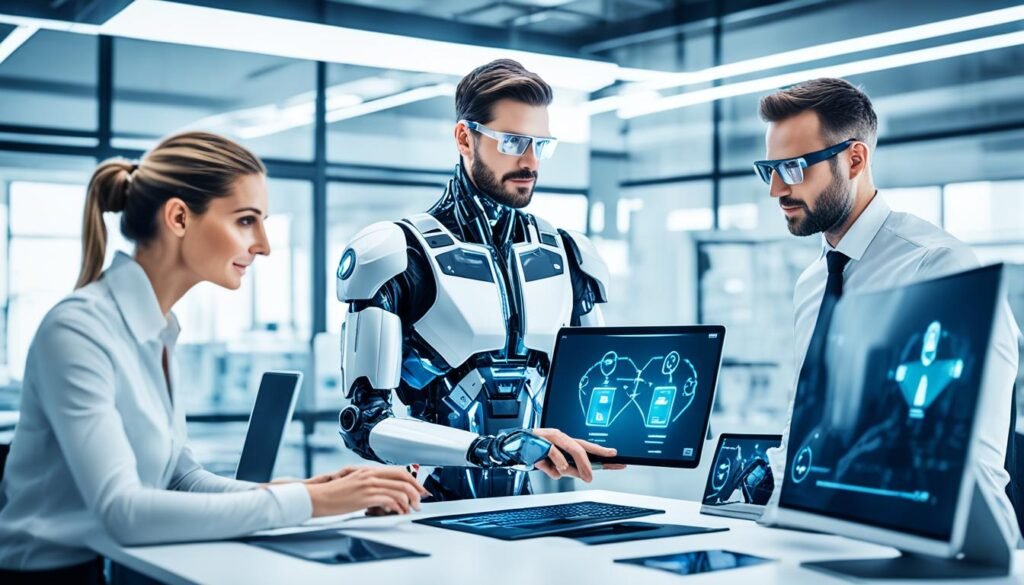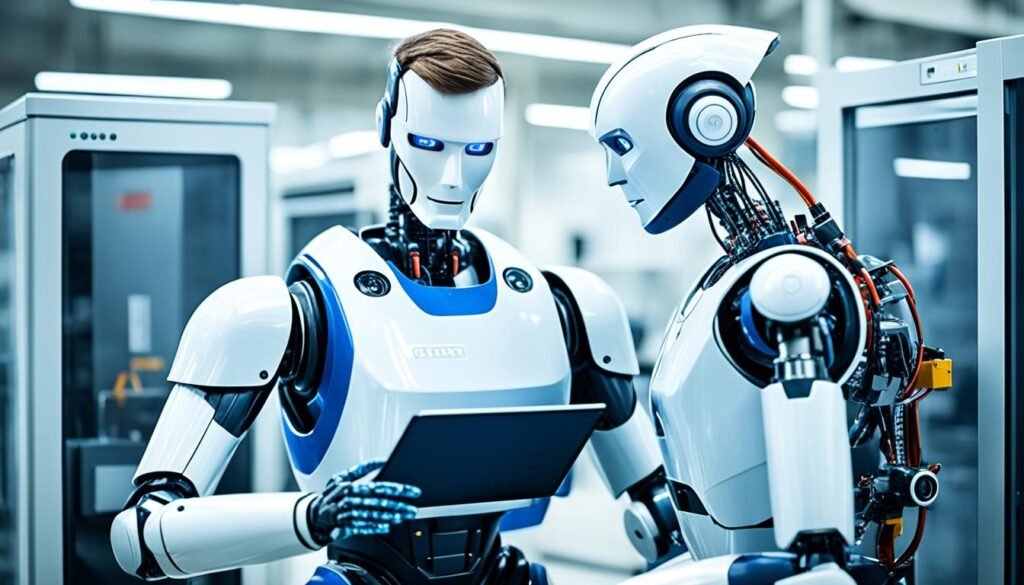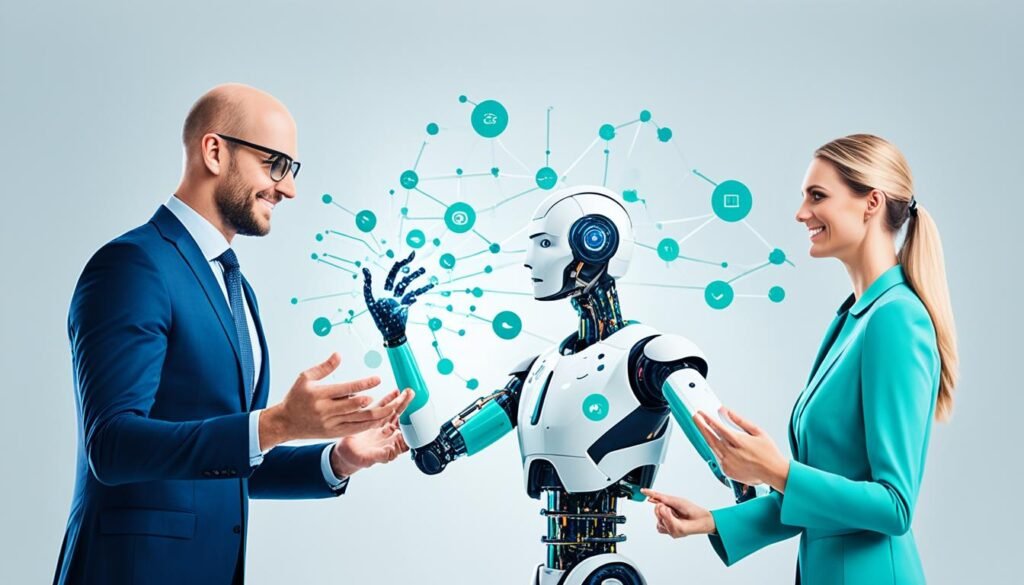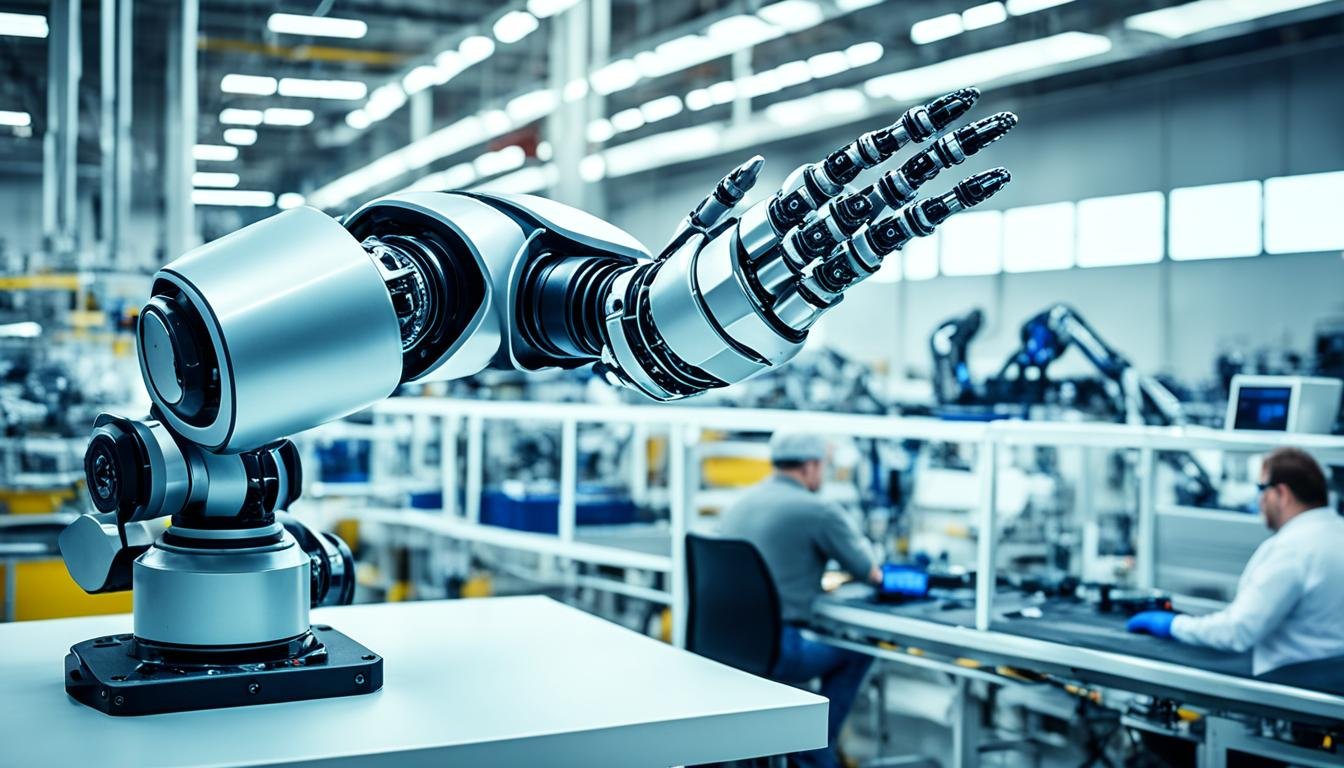A 2023 ResumeBuilder survey found a shocking 37% of companies using AI replaced workers with it. Also, 44% of companies expect AI to lead to layoffs in 2024. These numbers show a big worry about AI’s effect on jobs. But, the idea that AI will replace all human jobs is not true.
AI can automate some tasks, but its real strength is in helping humans. The secret to doing well in the AI age is to work on skills AI can’t match, like creativity and emotional smarts. By seeing AI as a tool, you can find new chances in the changing job world.
Key Takeaways
- AI won’t replace all human jobs, but it will change how we work.
- It’s important to develop skills like creativity and emotional smarts to stay ahead in the job market.
- Seeing AI as a tool to boost human skills is key to doing well in the AI future.
- AI will lead to more job changes, especially in white-collar jobs, but it won’t replace them all.
- Upskilling and adapting to the changing job scene is crucial for workers to succeed with AI.
The AI Revolution: Harnessing the Power of Technology
Artificial intelligence (AI) has changed many industries. It now helps with customer service, admin tasks, graphic design, and data entry. Even sectors like translation, advertising, and programming are seeing the effects of AI.
Identifying High-Risk Sectors for AI Displacement
Workers in high-risk sectors need to be aware of the AI threat. They should work with AI to improve their skills. This way, they can stay ahead in their fields.
Cultivating AI Innovation: Support, Not Supplant Human Jobs
AI should help make human jobs better, not replace them. Companies can use AI wisely to grow and tackle challenges. They should invest in training and set rules for ethical AI use.
As AI grows, companies that use it well and support their workers will do well. The future is for those who balance AI’s power with human touch.
| AI Impact on Industries | Jobs at Risk |
|---|---|
| Customer service, administrative roles, graphic design, data entry | Production workers, translators, advertising copywriters, delivery drivers, graphic designers, programmers |

“The future belongs to those who can strike a harmonious balance between the power of AI and the irreplaceable value of the human touch.”
The Upskilling Imperative: Embracing Change and Growth
As the age of AI changes traditional jobs, companies see AI as a chance to improve their workers. By offering ongoing learning and training, workers can get the skills for the AI era. This helps them keep up with job changes and work well with AI.
This approach also makes employees feel more secure and valuable. When workers see AI as a tool to make their jobs better, it leads to a smooth workforce transformation. This benefits both the worker and the company.
- Up to 30% of jobs could be at risk of automation by the early 2030s, according to studies by PwC.
- The translation industry has seen a decline in income due to AI advancements, reducing rates for translators and shifting their roles towards project management.
- AI and automation in the manufacturing industry have led to a decline in traditional manual labor jobs, with a higher demand for skilled professionals to manage AI-driven systems.
But not all jobs will be replaced by AI. Jobs that need complex decision-making, creativity, empathy, or physical skills are less likely to be fully automated. Examples include surgeons, nurses, therapists, social workers, teachers, research scientists, physical therapists, chefs, and emergency responders.
“The entire world of work is evolving due to the tipping point in AI technology and future advancements.”
By focusing on upskilling, companies can make sure their workers are ready for the changes brought by automation and AI. This helps the business grow and succeed in the long run.

Navigating the AI Landscape: Strategies for Upskilling
To keep up with the changing job market, workers need to be proactive in learning new skills. Companies can help by offering detailed training, mentorship, and access to new tools and tech.
- Identify high-risk sectors and job functions: Conduct thorough assessments to understand which roles are most vulnerable to AI displacement, and prioritize upskilling efforts accordingly.
- Foster a culture of continuous learning: Encourage employees to embrace a growth mindset, continuously seeking new knowledge and skills to future-proof their careers.
- Collaborate across the organization: Facilitate cross-functional collaboration and knowledge-sharing to create a more agile and adaptable workforce.
By embracing the upskilling imperative, both companies and their workers can handle the workforce transformation caused by AI. This puts them in a strong position for success and growth in the skills for the AI era.
Exploring the Hybrid Models: AI and Human Synergy
As AI becomes more common in work, companies face the challenge of balancing tech power with human insight. AI has amazing abilities, but it can’t do everything. Employees bring innovation and success that AI alone can’t match.
The Balancing Act: AI Integration and Human Oversight
Adding AI to work needs a careful plan that uses both tech and human skills. By having strong human checks, companies make sure AI works with their goals and values. This teamwork makes AI systems more reliable and trustworthy, and it helps build trust and power among workers.
Companies also need to set rules for AI decisions. This ensures that big choices about workers, customers, and others are checked by humans. It helps avoid AI mistakes and keeps the personal touch needed for good customer service and a happy workplace.
It’s also key to help employees learn and grow in an AI world. Training them to work well with AI lets companies use both to their fullest. This teamwork makes human-AI collaboration stronger, where each side helps the other.
| Aspect | Benefits of Human-AI Collaboration |
|---|---|
| Decision-making | AI gives data insights, while humans use their thinking and ethics for better decisions. |
| Problem-solving | AI quickly goes through big data, and humans use their creativity and understanding for new solutions. |
| Customer Service | AI handles simple questions well, and humans offer caring, tailored help for harder issues. |
| Content Creation | AI starts content, and humans add their special views, feelings, and editing skills. |
By using ai-human hybrid models, companies can find new ways to grow, innovate, and stay ahead. They keep the human touch that’s key for lasting success.

Deciphering the Economic Ripple Effect of AI Replacement
As advancements in AI technology continue to change things, the worry about job loss grows. But experts say AI’s effect on the economy is more complex. It brings both challenges and chances for jobs.
A Goldman Sachs report says over 300 million jobs could face AI disruption worldwide. McKinsey thinks at least 12 million Americans will move to new fields by 2030 thanks to AI. But, AI could also lead to new jobs, with nongenerative and generative AI adding $17 trillion to $26 trillion to the global economy in the future.
The World Economic Forum predicts a net loss of 14 million jobs globally due to AI in the next five years. They also think 44% of workers will need new skills in the same time frame. This shows we need to get ready for the changing job world.
| Potential Impact of AI on Jobs | Estimated Figures |
|---|---|
| Jobs disrupted by AI | Over 300 million worldwide |
| Americans switching fields due to AI | At least 12 million by 2030 |
| Net job loss due to AI over 5 years | 14 million globally |
| Projected change in workers’ core skills | 44% in the next 5 years |
AI’s short-term effect on the economy might be tough, but the long-term outlook is better. Dr. Matthew Bidwell from Wharton University says automation hasn’t wiped out jobs. Instead, it changes what workers do. By learning new skills and adapting, people can find new opportunities in the AI age.

“The positive impact of AI lies in making us more productive and facilitating the completion of tasks at a quicker pace, ultimately enhancing societal wealth due to increased efficiency.”
As AI’s effects on the economy become clearer, adapting and making the most of new job trends is key. By tackling the job displacement vs job creation issue, we can make sure AI’s impact on the economy is good and changes things for the better.
Why AI Won’t Replace Jobs
AI’s rapid growth has raised concerns about job loss. But, the truth is, AI will likely boost and improve human skills more than replace them. Human skills like intuition, emotional smarts, and creative problem-solving are key in many areas. They can’t be easily copied by AI.
A study with 12,000 workers worldwide found that 81% of employees like using both human insight and AI to solve problems. This shows workers see AI as a tool to boost their skills, not a threat to their jobs.
Also, AI automation is likely to create new jobs while it replaces some. The World Economic Forum says 85 million jobs could change due to the new human-machine balance. But, 97 million new roles might come up that fit the new dynamic better.
| Roles Susceptible to AI Replacement | Roles Complementary to AI |
|---|---|
|
|
AI can automate some tasks but can’t replace human touch in areas like people management and medical care. These fields need empathy, intuition, and problem-solving skills that AI hasn’t mastered yet. By seeing AI as a tool to improve human skills, workers can work with technology to boost productivity and innovation.
“AI is more likely to augment and enhance human capabilities than to completely replace human workers.”
The Human Touch: Preserving Empathy and Intuition
In the age of artificial intelligence (AI), we often focus on tech advancements. But, it’s key to value human skills at work. AI is great at analyzing data and spotting patterns. Yet, it can’t match human empathy, intuition, and emotional smarts.
These skills are crucial in healthcare, customer service, and human resources. They can’t be replaced by machines. As AI grows more common, keeping and using human skills is vital for success in the AI age.
Emotional Intelligence: AI’s Achilles’ Heel
Emotional intelligence lets us understand and manage our feelings. AI hasn’t mastered this yet. In customer service, being able to empathize and read non-verbal signals is key. It helps build trust and strong connections with customers.
In healthcare and human resources, empathy and intuition are crucial. They help understand people’s needs and provide support. As AI gets better, keeping and improving these unique human skills will help companies stay ahead and offer top-notch service.
“The most powerful technologies are those that empower people, not replace them. AI should be designed to enhance and augment human capabilities, not automate them away.”
By balancing AI with human know-how, companies can use technology wisely. They can keep the empathy and intuition vital for today’s work. The secret to doing well in the AI era is to value the human touch and blend it with AI’s power.
Collaborative Paradigms: Humans and AI Working Together
The future of work will blend humans and AI in a powerful way. Instead of seeing AI as a threat, we should see it as a tool to augment our capabilities. By mastering AI, workers can automate simple tasks. This frees up time for more complex, strategic, and creative work.
This approach to ai-human collaboration will lead to new levels of efficiency, innovation, and growth. It’s a win-win situation for everyone.
Augmenting Human Capabilities with AI
Studies suggest that by 2030, AI will automate 30% of simple tasks at work. AI has already cut after-call work time for customer service reps by over 50%. It’s also improving communication by reducing language barriers.
AI keeps workplaces connected and helps teams work better together. It uses predictive analytics to match strategies with trends, giving companies an edge. AI tools also help make decisions by analyzing lots of data quickly.
This shift to new job roles in the ai era is changing how we work and collaborate. It’s exciting to see what the future holds.
“AI is not here to replace us, but to augment our abilities and unlock new possibilities.”
By working with AI, employees can focus on developing skills like critical thinking and strategic planning. These are skills that AI can’t replace. The partnership between humans and AI will lead to new levels of innovation and success in the future.
Embracing the Future: Strategies for Adapting to AI
The AI revolution is changing many industries. It’s important for you to keep up and make your career future-proof. Start by learning about the latest AI trends and how they might change your field. Look into new career paths that use your skills in ways that work well with AI.
See how AI can change your work for the better. Keep learning new skills to match the changing job market. Focus on your unique human skills like creativity, critical thinking, and emotional intelligence. This way, you’ll be ready for the AI age.
To get ready for the AI era, plan carefully. Work with AI systems to make your work better. Keep up with AI training programs and workshops from leaders in your field. With a flexible mindset and a love for learning, you can handle the AI changes and use them to your advantage.
FAQ
Why won’t AI replace jobs?
AI won’t replace jobs because it’s meant to help, not harm. It can automate some tasks, but human skills like creativity and emotional smarts are still key. By working with AI, people can keep up with job changes and do their jobs better.
Which job sectors are most susceptible to AI displacement?
AI is changing many jobs, like customer service and graphic design. Jobs in translation and advertising are also at risk. But, it won’t happen overnight. Workers in these fields can use AI to their advantage instead of being replaced.
How can organizations harness the opportunities and address the challenges posed by AI?
The goal is to use AI to boost human skills, not replace them. Companies should blend AI into their plans carefully. This means training staff and setting rules for ethical AI use to keep a balance between AI and human workers.
How can employees adapt to the changing job market due to AI?
AI is changing jobs, but it’s a chance for workers to get better skills. By learning new things, employees can work well with AI. This helps them do their jobs better and feel more secure in their careers.
How can organizations strike a balance between AI and human workers?
Using AI at work needs a careful balance between tech and people. AI is great but can’t do everything. By having human checks, setting AI rules, and training staff, companies can use AI and human skills together well.
What are the economic implications of AI replacement?
AI could change the economy by creating new job losses and gains. Experts think AI will lead to more jobs overall. By learning new skills, workers can move into new roles and benefit from AI’s changes.
What unique human abilities can AI not replicate?
AI can’t match human skills like intuition and creativity. These are crucial in many areas. By working with AI, people can use their unique skills to do new and innovative things.
How can businesses and employees leverage human skills in the age of AI?
AI is good at some things but can’t replace human empathy and creativity. These skills are key in areas like healthcare and customer service. As AI gets better, using these human skills will help businesses and workers succeed.
How can employees collaborate with AI to enhance their capabilities?
The future is about working together with AI. Employees should see AI as a tool to improve their work. By learning to use AI, workers can focus on complex tasks and grow professionally.
How can employees adapt to the AI-driven job market?
To adapt to AI, employees need to be proactive. They should keep up with AI news, explore new jobs, and learn how AI can help them. By embracing AI’s potential, workers can stay ahead in the changing job world.
